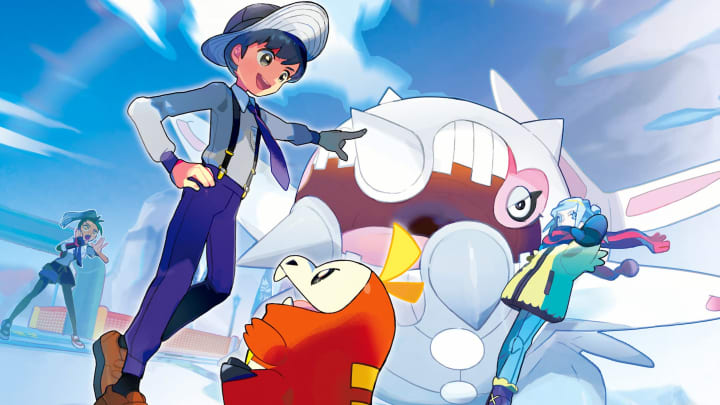All Pokémon games ranked from easy to impossible

Pokémon games aren’t exactly known for their difficulty. In fact, many of the games in the series – especially in some more recent entries – are downright easy, with next to no challenge throughout the entire game. It makes sense, of course, as these games are aimed at children primarily, but that doesn’t mean the series is a stranger to difficult challenges.
While FromSoftware’s Souls games are the benchmark for difficult gaming, and Pokémon doesn’t get anywhere near close to that, some of the games in the series are surprisingly challenging, especially if you go for optional content. Nothing in these games is strictly impossible, but some of the battles you’ll come across will have you grinding, looking up strategies, and bringing legendary Pokémon into the fight, just in case.
We’ve ranked every Pokémon game from easy to impossible, sticking to one representative game from each major release — that means Emerald is on the list, but Ruby and Sapphire aren’t. We’ve also steered clear of remakes, because while some of them do have some more difficult aspects, the main story difficulty is largely the same.
For more Pokémon rankings, check out our rankings of the best Pokémon games.
Pokémon X and Y
Pokémon X and Y were the first true 3D games in the series, and Game Freak saw it as a new entry point for a lot of players. Because of this, Pokémon X and Y is almost laughably easy — you get two starter Pokémon, one from Gen 6 and one from Gen 1, plus a free Mega Lucario, and the changes to the EXP Share meant you were pretty much always outpacing your enemies. Coupled with a low level of trainer AI and the lack of any sort of post-game challenge, plus the instant win button that is Mega Evolution, there’s really nothing to challenge you in X and Y.
Pokémon Sword and Shield
Sword and Shield had a similar problem to X and Y, in that it was an easy jumping in point for a lot of new Switch owners and couldn’t afford to be particularly challenging. The EXP Share is always on, although the game doesn’t really feel balanced for it, and trainer AI isn’t super smart, either. The big moments of the game, like the battle against Eternatus, are basically impossible to lose, and Dynamax, like Mega Evolution before it, gives you an instant win button in most places where it counts. That said, the post-game Battle Tower has some decent challenge to it, and the DLC, while not particularly tough, has some fun fights too, so it’s better than X and Y by a decent chunk.
Pokémon Red and Blue
Red and Blue is where the series all began, and while you might remember it as being quite difficult, most of that is probably just because you were a dumb kid. These first generation games are all kinds of broken, and it’s not difficult to power through the entire game with just a single Pokémon. That said, while there aren’t many huge challenges in the game, the lack of options for diversifying your team meant that taking down some gyms, like Sabrina’s gym, was a bit of a struggle.
Pokémon Crystal
Crystal – and all Gen 2 Pokémon games – suffer from a pacing issue. Because there was an entire second region in the game, complete with gym challenges and a second run through the Elite Four, the level curve in the first half of the game is brutally short. The most powerful Pokémon you’ll face prior to Kanto is a level 50 Dragonite, and if you’ve been fighting most trainers and a few wild Pokémon here and there, you’re almost guaranteed to be overleveled long before you get to the Elite Four. It’s improved somewhat in the post-game, although most gyms are still quite underleveled, and only saved at the last second with one of the most difficult fights in the series, against Red on the top of Mount Silver. It’s a brutal fight, with Pokémon in the high 70s, including a Snorlax that will wall you pretty hard if you’re not prepared. If it wasn’t for this fight, it would be much lower in the list.
Pokémon Emerald
Emerald took the relative ease of Pokémon Ruby and Sapphire and turned it up a notch, offering stronger gym leaders and more challenging fights throughout the story. Like Crystal, it also has a post-game fight against a former champion, this time Steven, who packs a real punch with his team of Rock-, Ground-, and Steel-type Pokémon, but the real challenge comes from the Battle Frontier. The Battle Frontier is made for competitive players, and you can’t just waltz on in without a plan and expect to win. It’s optional content, sure, but it’s very challenging nonetheless.
Pokémon Black and White
Pokémon Black and White’s main story isn’t super difficult, but the post-game makes up for it. Like Sword and Shield, Black and White has a Battle Tower equivalent in the Battle Subway, which is quite challenging. But it also has a post-game fight with a former champion, the terrifying Cynthia. If you visit her in her beach house, she will gladly give you a walloping, with her signature Garchomp being ready and able to dispatch most of your team. The actual champion of the region is a post-game fight, too, with Alder being not super difficult, but difficult enough to be a challenge if you’re not prepared. Black 2 and White 2 also had difficulty settings, but you had to start a new game to access them, so they weren't great.
Pokémon Platinum
Diamond and Pearl introduced the terror that is Cynthia to the world, with her menacing encounter theme only matched by her prowess in battle. Cynthia’s team is stacked, in both those games and in Platinum, but Platinum goes even further by making most gym leaders more powerful. As with Emerald, Platinum gets even more difficult when you take on the Battle Frontier, and there’s a post-game fight against the rival that had the strongest Pokémon in the series prior to the release of HeartGold and SoulSilver. Mostly, though, it’s Cynthia that terrifies us.
Pokémon Scarlet and Violet
Scarlet and Violet’s base game has five champion-level trainers to fight against — Geeta, Nemona, Penny, Arven, and the Professor in the end-game. They’re all (except for Penny and arguably Geeta) quite challenging fights, but the true challenge comes in the post-game DLC, specifically in the Indigo Disk. Here, you’ll be thrust into Blueberry Academy, where there’s a whole new Elite Four to fight against in VGC-style double battles, some of whom have the smartest trainer AI in the series. It’s all topped off with a fight against the Blueberry champion, Kieran, who has a full team of competitive Pokémon ripped straight from the pages of Smogon, including Dragonite, Politoed, Porygon-Z, and competitive darling Incineroar, complete with its Intimidate hidden ability. It’s one of the most difficult champion battles in the series, and it absolutely rules.
Pokémon Ultra Sun and Ultra Moon
Ultra Sun and Ultra Moon have two things making them some of the most difficult games in the series: a surprisingly tough battle against Ultra Necrozma, and the Team Rainbow Rocket post-game episode. The former starts the battle with +1 in all stats, and comes at a time that you’re unlikely to be prepared for, while the latter pits you against every single villainous team leader from the series’ past, all of whom have had some serious upgrades. Add the region’s already challenging Battle Tree, and the new Battle Agency, and you’ve got a game that punches well above its weight for most of the series. There is one more game, though…
Pokémon Legends: Arceus
Pokémon Legends: Arceus doesn’t have a lot of trainer battles, but the battle system in general is very different. The changes to move order put you on your toes throughout the entire game, and battles against giant Noble Pokémon require actual dexterity to pull off, too. Things get tougher in post-game updates, with the Paths of Solitude and Tenacity and the Eternal Battle Reverie offering plenty of challenges. The real clincher, though, is the final battle against Volo, Cynthia’s ancestor. Volo uses a team similar to his descendent, but adds an illegal seventh Pokémon to the mix: Giratina. And you have to fight Giratina twice. If you weren’t prepared for this, you were thumped by Volo. If you were prepared, you were still thumped by Volo. It’s by far one of the most difficult fights in the series, if not the most difficult outside of battle facilities.
